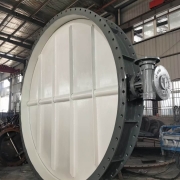Structural Characteristics and application of Centerline Butterfly Valves
Centerline butterfly valve is one of the most common types of butterfly valves, mainly including centerline wafer butterfly valve and centerline flanged butterfly valve. In today’s article, we mainly talk about the structural characteristics and usage instructions of the centerline butterfly valve.

ductile iron, DI, butterfly valve, manufacturer, center line, TH valve
Structural characteristics of centerline butterfly valve
The composition of the centerline butterfly valve mainly includes the valve body, the butterfly plate, the valve stem, the valve seat and the actuator. The actuator mainly includes handle, turbine head, electric head, pneumatic head, etc. The valve body is made by integral casting process. The valve seat sealing ring is made of rubber and is inlaid on the valve body. A shaft sleeve is designed in the two shaft holes of the valve body to provide support and lubrication for the valve stem.
The operation of the centerline butterfly valve is also very simple. Take the handle centerline butterfly valve as an example. Pull the handle to rotate clockwise or counterclockwise, the handle drives the valve stem, and the valve stem drives the butterfly plate to rotate 90° to complete the opening and closing of the butterfly valve. The whole process is also very labor-saving.
Instructions for use of centerline butterfly valve
1. Avoid bumps and scratches during transportation;
2. Do not store in the open air during storage, avoid the valve from being exposed to sunlight or rain, pay attention to ensure the ventilation of the storage place, and keep the valve dry.
3. The following preparations should be done before installation of the centerline butterfly valve:
① Carefully check whether the valve used conforms to the performance specifications required by the operating conditions.
②Clean the sealing surface of the valve body without any impurities and dirt, and do not open or close the valve plate before cleaning.
③ Clean the inside of the pipeline to be installed, and there must be no dirt or debris.
④ Check whether the drive device can be used normally.
4. The installation position should be reasonable, and the installation position of the valve should be ensured to be convenient for use, maintenance or replacement. In addition, it is not necessary to consider the flow direction of the pipeline medium during installation.
5. Pipe flanges must use special flanges.
6. After the centerline butterfly valve is installed, it should be checked regularly during use. The main items to check are as follows:
① Whether the butterfly valve seat and O-ring seal are damaged or corroded.
②Whether the valve plate sealing surface is damaged or corroded.
Note: After each inspection, the inspection results should be recorded in detail for future reference.
TH Valve is a professional manufacturer of butterfly valve, gate valve, check valve, globe valve, knife gate valve, ball valve with API, JIS, DIN standard, used in Oil, Gas, Marine industry, Water supply and drainage, fire fighting, shipbuilding, water treatment and other systems, with Nominal Diameter of DN50 to DN1200, NBR/EPDM/VITON, Certificates & Approvals: DNV-GL, Lloyds, DNV, BV, API, ABS, CCS. Standards: EN 593, API609, API6D
Video of center-lined butterfly valve:
Related news/knowledge:
Characteristics of the centerline wafer butterfly valve
Centerline flange butterfly valve
Commonly used valve body materials of centerline wafer butterfly valve
Advantages and Features of Center-lined Wafer Butterfly Valve

 tanghaivalve.com
tanghaivalve.com 

 © Copyright 2020 Tianjin Tanghaidongyang Valve Co., Ltd. All Rights Reserved.
© Copyright 2020 Tianjin Tanghaidongyang Valve Co., Ltd. All Rights Reserved.